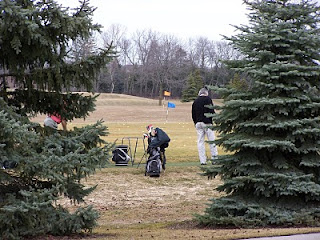 The snow has melted and the golf season is soon approaching. At this time of the year I am frequently asked two questions: "How's the course?" and "When will we open?". As one would expect these two questions are linked together as the decision of opening the course is dependent upon the condition of the turf and soil. I will give a brief answer to the questions below.
The snow has melted and the golf season is soon approaching. At this time of the year I am frequently asked two questions: "How's the course?" and "When will we open?". As one would expect these two questions are linked together as the decision of opening the course is dependent upon the condition of the turf and soil. I will give a brief answer to the questions below.How's the course?
- Greens--Overall the greens survived the winter well, exhibiting no signs of fungal activity and minimal winter damage. Snow was removed from the greens which contained extensive ice cover (8W,9W,6B,7B,8B,9B,PG) on March 3 and 4. A few areas on these greens have exhibit signs of injury, but not to the extent that we have witnessed in the past. We will continue with our usual spring cultural practices, such as aggressive vertical mowing, and supplement with additional fertilizer in order to foster growth and recovery.
- Tees--The tees are in outstanding condition following winter. I have yet to see a tee that exhibits any sign of winter damage or fungal activity.
- Fairways--As is usually the case, the fairways at NSCC are most susceptible to winter damage. Because NSCC's topography is relatively flat, the potential exists that any snow melt or rain can accumulate and refreeze on low-lying fairway areas. This winter proved to be no exception. During a warm stretch in mid-January, we received .75" of rain which melted and additional 8" of snow cover. The unfrozen, standing water conditions lasted for two days before lower temperatures created sheets of ice. Over this time the water penetrated the crowns, or growing points, of the turfgrass plants. The rapid freezing damaged plant cells in the crowns. The ice cover that followed put additional stress on the damaged turfgrass plants. The amount of damage varies throughout the golf course, with the Blue nine sustaining the greatest amount of damage. The NSCC golf course maintenance staff will be repairing these areas as soon as the course dries sufficiently to allow for equipment access. Damaged areas will be seeded, fertilized, and covered to facilitate recovery. Be sure to visit to blog in the near future for an update on the repair work.
When will the golf course open?
In order to open frost must leave the ground, the soil in fairways, tees, and green must dry enough to support foot traffic without causing damage, and the greens must be growing sufficiently to survive the wear which it receives from play. Opening prematurely, can negatively impact course conditions for the remainder of the season. Due to NSCC's close proximity to Lake Michigan, the above mentioned criteria for opening will often be met at a later date than our inland neighbors. Historically, NSCC has opened around April 1.
What is the opening schedule?
- The Red nine will open first.
- The White nine will open second. Originally, the White nine was scheduled to open on May 1 in order to give the golf course maintenance staff the ability to fine tune last fall's reconstruction work. Fairway conditions on the Blue nine will force us to open the White nine second. All course work, including stump hole filling and seeding will be completed as soon as possible.
- The Blue nine will open last. The extensive repair work required on the Blue nine will limit the playability of the fairways. Large areas of delicate seedlings that are protected by insulating covers will not be conducive for play. The opening date for the Blue nine is dependent upon the spring weather and the progressive of the repair work.
- The practice range is currently open. Be sure to check with pro shop to verify this should we receive any rain.





